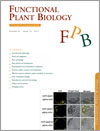
Functional Plant Biology
Volume 44 Number 10 2017
FP17042Emerging evidence for potential role of Ca2+-ATPase-mediated calcium accumulation in symbiosomes of infected root nodule cells
Although Ca2+ is transported by Ca2+-ATPase into root nodule cell symbiosomes, surprisingly little is known on its role in their functioning. An attempt to solve the problem was made using the data on calcium behaviour in prokaryotes and endosymbiosis role in its signalling. The data outlined indicate that Ca2+ signalling in bacteroids is putatively its key functional role in symbiosomes.
FP17003Melatonin alleviates aluminium toxicity through modulating antioxidative enzymes and enhancing organic acid anion exudation in soybean
Aluminium (Al) toxicity is a significant problem for plant growth and production on acidic soils, which cover over 40% of the world’s arable land. In this study, we investigated the role of melatonin in soybean resistance to Al toxicity. The application of melatonin alleviated Al toxicity through enhancement of antioxidant enzymes activities and organic acid anions exudation.
FP16406Solute transport within grape berries inferred from the paramagnetic properties of manganese
Mineral transport in plants is typically studied using chemical tracer compounds. However, after grape berries begin to ripen, xylem mobile tracers are often constrained to the vasculature near the proximal end. Here we show it is possible to observe the transport of important minerals, such as Mn, using magnetic resonance imaging.
FP17121PSI becomes more tolerant to fluoranthene through the initiation of cyclic electron flow
Floranthene (FLT), a polycyclic aromatic hydrocarbons (PAH) poses a potential ecological risk to plants by damaging their photosynthetic machinery. It inhibits PSII while PSI protects itself from the damaging effects of FLT by initiating cyclic electron flow. This important information was provided using a very quick, noninvasive and simple technique of chlorophyll a fluorescence measurement.
FP17024Relative functional and optical absorption cross-sections of PSII and other photosynthetic parameters monitored in situ, at a distance with a time resolution of a few seconds, using a prototype light induced fluorescence transient (LIFT) device
A new approach to monitoring leaf photosynthesis in situ using 30 ms chlorophyll fluorescence transients at ~ 2 s intervals at distances up to 2 m is described. By monitoring fluorescence with near full reduction of QA (the primary quinone acceptor of PSII) these transients deliver parameters not directly available from other methods (relative functional absorption cross section of photosystem II, rates of intersystem electron transport and relative oxidation state the plastoquinone (PQ) pool). These permit non-intrusive evaluation of brief sun flecks in shade canopies whereas calibration against traditional PAM methods is obtained in longer protocols achieving full reduction of PQ.
FP16410Physiological and biochemical responses of Festuca sinensis seedlings to temperature and soil moisture stress
Drought and cold are two major factors limiting the growth of cool-season grasses and cause declines in grassland and forage quality. This study investigated the physiological and biochemical responses of one native grass species – Festuca sinensis – in China to temperature and water stress. Our results showed this grass could adapt to certain changes in the ecological environment by regulating their physiological and biochemical reactions.
FP17038Ozone triggers different defence mechanisms against powdery mildew (Blumeria graminis DC. Speer f. sp. tritici) in susceptible and resistant wheat genotypes
Ozone has been proposed as a convenient elicitor against pathogens. We hypothesised that ozone treatment may elicit defence against Blumeria graminis f. sp. tritici (Bgt) by inducing ROS signalling or other defence routes in wheat. We found that ozone treatment was effective in diminishing Bgt invasion in the susceptible cultivar, which was plausibly related to the SA pathway.
FP17113Phosphatidic acid binds to and regulates guanine nucleotide exchange factor 8 (GEF8) activity in Arabidopsis
Both phosphatidic acid (PA) and guanine nucleotide exchange factors (GEFs) are essential signalling molecules in adaptive response to various external stresses. Here we show that PA binds specifically to GEF8, thus regulating the activity of small GTPase ROPs in Arabidopsis. Our findings identify a direct functional regulation of lipid-mediation of GEFs activity and small GTPase signalling in cells.
FP17098Croton blanchetianus modulates its morphophysiological responses to tolerate drought in a tropical dry forest
Understanding morphophysiological variations in plant leaf traits on tropical dry forests is essential for studying global climate changes. We was investigated the effect of rainfall on the morphophysiological features of Croton blanchetianus. We argue that C. blanchetianus has a remarkable ability to adapt to global climate changes. Consequently, this species may be important in reforestation programs.



